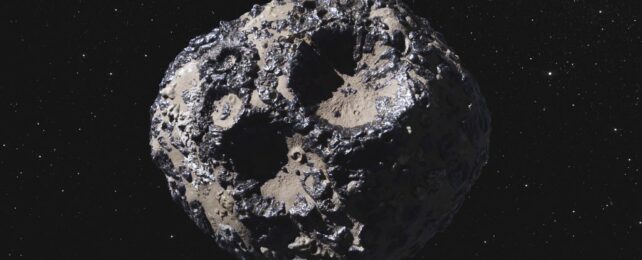 Artist's impression of metallic asteroid Psyche. (NASA)
Artist's impression of metallic asteroid Psyche. (NASA)The densest naturally occurring element found on the periodic table is osmium, a metal that solidifies at room temperature with a density of 22.59 grams per cubic centimeter. This density is nearly twice that of Earth's inner core and almost comparable to Jupiter's core.
However, intriguingly, there are celestial objects in our Solar System, specifically asteroids, that appear to possess even greater density than osmium. This is surprising because asteroids lack the mass required to compress minerals into such an ultradense state, a phenomenon observed in planetary cores.
Scientists have been led to ponder the existence of stable elements beyond the known periodic table, surpassing the unstable, radioactive superheavy elements with atomic numbers ranging from 105 to 118, which have only been artificially produced in laboratory environments.
The possibility of elements with more than 118 protons being stable remains unknown, as they have never been observed in natural or laboratory settings. Theoretical research, however, hints at an "island of stability" around atomic number 164. Here, superheavy elements might be less prone to radioactive decay, potentially existing for a considerable period.
The prospect of these heavier elements being denser offers a potential explanation for the peculiar observations surrounding asteroid 33 Polyhymnia, a rocky body in the asteroid belt measuring approximately 50 to 60 kilometers (around 30 to 36 miles) in diameter. A measurement derived a density of 75.28 grams per cubic centimeter for 33 Polyhymnia, categorizing it as a potential compact ultradense object (CUDO).
Although such an extreme outlier is likely due to a flawed measurement, physicists from the University of Arizona, Evan LaForge, Will Price, and Johann Rafelski, sought to explore the physical plausibility of such density. They employed the Thomas-Fermi model, a basic approximation of atomic behaviors, to investigate the atomic structure of hypothetical superheavy elements.
Despite the model's imprecision, it enabled the researchers to systematically explore atomic behavior beyond the known periodic table. Their calculations aligned with the previously predicted island of stability at atomic number 164. They demonstrated that the density range of this hypothetical element falls between 36 and 68.4 grams per cubic centimeter, a range comparable to the high-density calculation for 33 Polyhymnia.
This does not confirm that 33 Polyhymnia is ultradense; instead, it suggests a plausible explanation for the possibly flawed ultradensity measurement, eliminating the need for invoking mysterious or dark matter.
In their paper, the researchers noted, "The purpose of this study was to determine whether CUDOs with extreme mass density could be achieved without the need for the usually invoked strange or dark matter. We have done this while exploring two different nuclear systems using the relativistic Thomas-Fermi model. From the exploration of both standard nuclei and alpha matter, it is clear that both types of nuclear matter could explain the density seen in CUDOs such as asteroid 33 Polyhymnia."
This study highlights the usefulness of the Thomas-Fermi model in investigating the properties of hypothetical superheavy elements, laying the groundwork for more comprehensive analyses in the future.
The research appears in The European Physical Journal Plus.





No comments:
Post a Comment